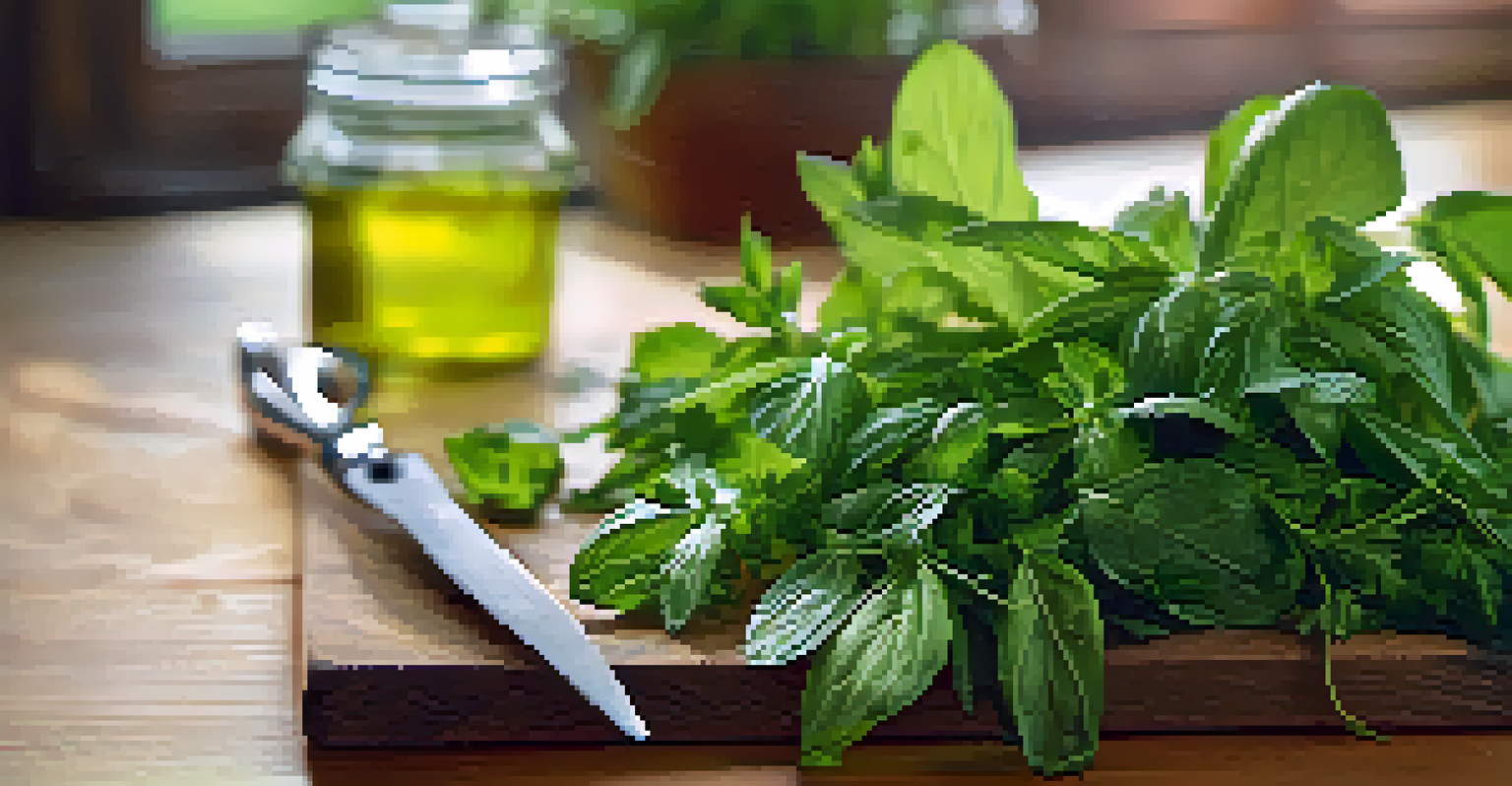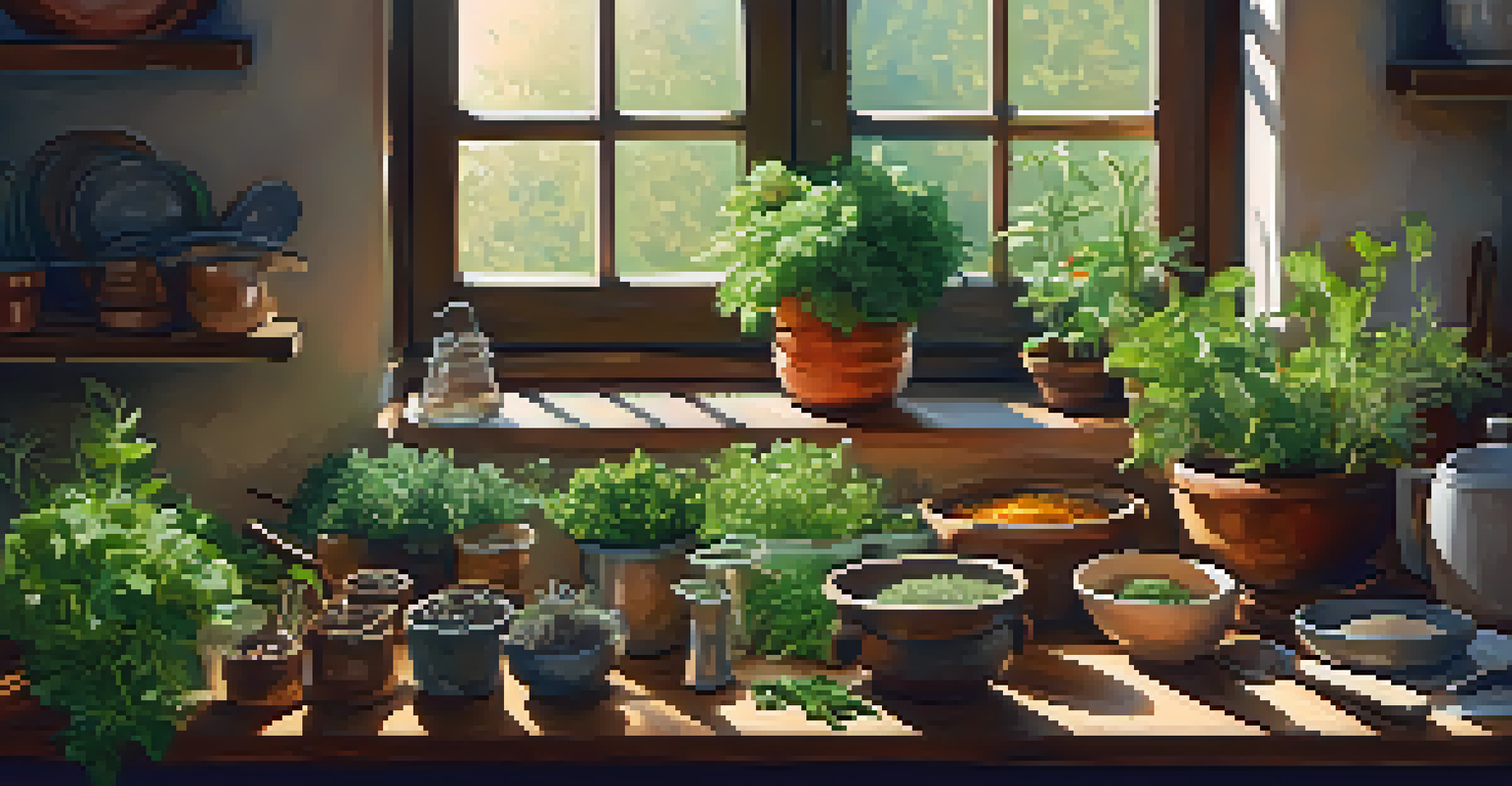How to Start Your Own Herb Garden for Vegan Recipes

Why Growing Your Own Herbs is Beneficial for Vegan Cooking
Growing your own herbs is a fantastic way to elevate your vegan dishes. Fresh herbs add vibrant flavors that can transform simple meals into culinary delights. Plus, when you grow them yourself, you know exactly what goes into your garden, ensuring no pesticides or chemicals are involved.
Herbs are the spice of life, and growing them can transform your cooking from good to great.
Imagine stepping outside to snip a handful of basil or cilantro for your favorite recipe. It’s not just about the taste; it’s also about the joy of nurturing a plant from seed to harvest. This connection to your food can make your cooking experience more fulfilling and enjoyable.
Additionally, fresh herbs are packed with nutrients and antioxidants, contributing to a healthier lifestyle. By incorporating homegrown herbs into your vegan meals, not only do you enhance flavors, but you also boost the nutritional value of your dishes.
Choosing the Right Location for Your Herb Garden
The first step in starting your herb garden is selecting the perfect location. Herbs typically thrive in sunny spots, so look for a place that gets at least 6-8 hours of sunlight each day. This could be a sunny windowsill, balcony, or even a small patch in your yard.

Consider the climate in your area as well. Some herbs, like basil, love warm weather, while others, like mint, can handle a bit of shade. If you’re limited on space, remember that many herbs can also be grown in pots, allowing for flexibility in your gardening setup.
Fresh Herbs Enhance Vegan Dishes
Growing your own herbs adds vibrant flavors and nutritional benefits to your vegan cooking.
Lastly, make sure the spot has good drainage. Herbs dislike sitting in water, which can lead to root rot. A well-drained area will help keep your plants healthy and flourishing throughout the growing season.
Selecting the Best Herbs for Your Vegan Recipes
When choosing herbs to grow, think about the vegan recipes you enjoy most. Popular choices include basil, cilantro, parsley, and thyme, all of which can enhance a variety of dishes. By selecting herbs you frequently use, you’ll ensure your garden is both practical and enjoyable.
To plant a garden is to believe in tomorrow.
If you’re new to herb gardening, start with a few easy-to-grow varieties. Basil, for instance, is forgiving and grows quickly, making it a great choice for beginners. As you gain confidence, you can expand your garden to include more diverse herbs like dill or rosemary.
Consider your cooking style as well. If you love Mediterranean cuisine, focus on herbs like oregano and sage. For Asian dishes, cilantro and lemongrass are fantastic options. Tailoring your herb selection to your culinary preferences will make your garden more rewarding.
Understanding Soil and Water Needs for Herbs
Herbs generally prefer well-draining soil rich in organic matter. A good potting mix or a homemade compost blend can provide the nutrients your herbs need to thrive. If you're growing directly in the ground, enriching your soil with compost can also make a significant difference.
Watering is another crucial aspect of herb gardening. Most herbs prefer to be watered thoroughly but infrequently, allowing the soil to dry out between waterings. This approach encourages deep root growth and prevents overwatering, which can lead to disease.
Choose the Right Herbs for Cooking
Selecting herbs based on your favorite vegan recipes ensures a practical and enjoyable gardening experience.
Keep an eye on your herbs, especially during hot weather, as they might need more frequent watering. A good rule of thumb is to check the soil moisture by sticking your finger into the soil; if it feels dry an inch down, it’s time to water.
Planting Your Herbs: Seeds vs. Seedlings
When it comes to planting, you have two main options: starting from seeds or buying seedlings. Seeds can be more economical and offer a wider variety of herbs to choose from, but they require more patience and care. If you’re eager to get started, purchasing seedlings from a nursery can provide instant gratification.
If you choose seeds, follow the package instructions for planting depth and spacing. Generally, you’ll want to plant them in small pots or directly in your garden bed, depending on your setup. Be sure to keep the soil consistently moist until the seeds germinate.
On the other hand, if you opt for seedlings, gently transplant them into your garden or pots, ensuring not to damage the roots. Whichever method you choose, remember that your herbs will need time to establish themselves before you can start harvesting.
Caring for Your Herb Garden: Tips for Success
Caring for your herb garden involves regular maintenance to keep your plants healthy. This includes monitoring for pests and diseases, which can sometimes be a challenge. A simple solution is to inspect your plants regularly and remove any affected leaves or pests by hand.
Fertilizing is another part of herb care. While herbs don’t require heavy feeding, a light application of organic fertilizer every few weeks can help promote growth. Just be careful not to over-fertilize, as this can lead to overly lush leaves with diminished flavor.
Proper Care Leads to Healthy Herbs
Regular maintenance, including monitoring for pests and proper watering, is crucial for a thriving herb garden.
Don’t forget to prune your herbs regularly. This encourages bushy growth and prevents them from becoming leggy. Snipping off the tops of your herbs can actually enhance their flavor and yield, giving you more to enjoy in your vegan recipes.
Harvesting and Using Your Fresh Herbs
The moment has finally arrived: it’s time to harvest your herbs! The best time to do this is in the morning after the dew has dried but before the sun gets too hot. This ensures the essential oils in the herbs are at their peak, giving you the best flavors for your dishes.
When harvesting, use clean scissors or garden shears to snip off leaves or stems. Always leave enough foliage on the plant to allow for continued growth. If you're unsure how much to take, start with a small amount; you can always come back for more as your herbs continue to flourish.

Finally, get creative in the kitchen! Fresh herbs can be used in various ways, from garnishing dishes to infusing oils or making pesto. The possibilities are endless, and incorporating your homegrown herbs into your vegan recipes will surely impress your taste buds and your guests.